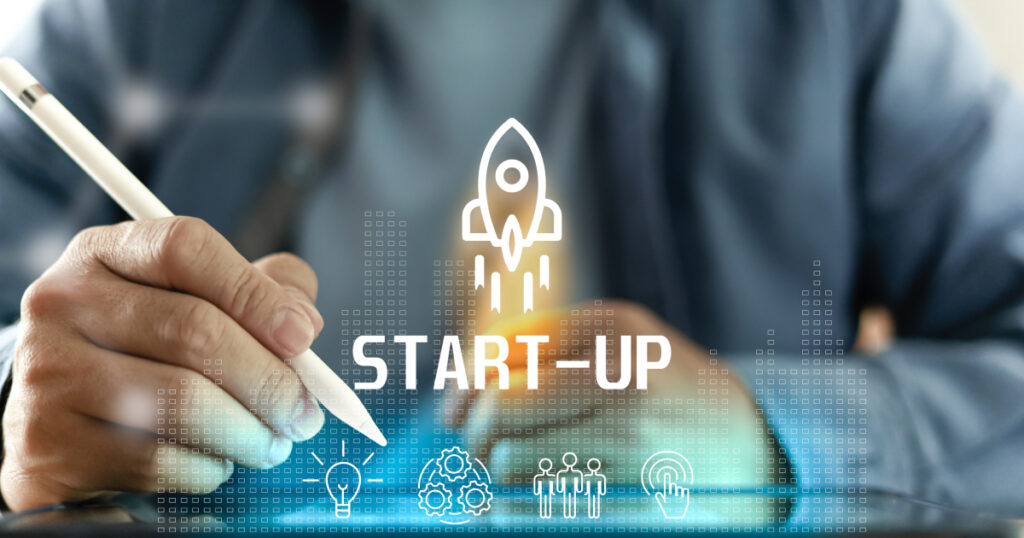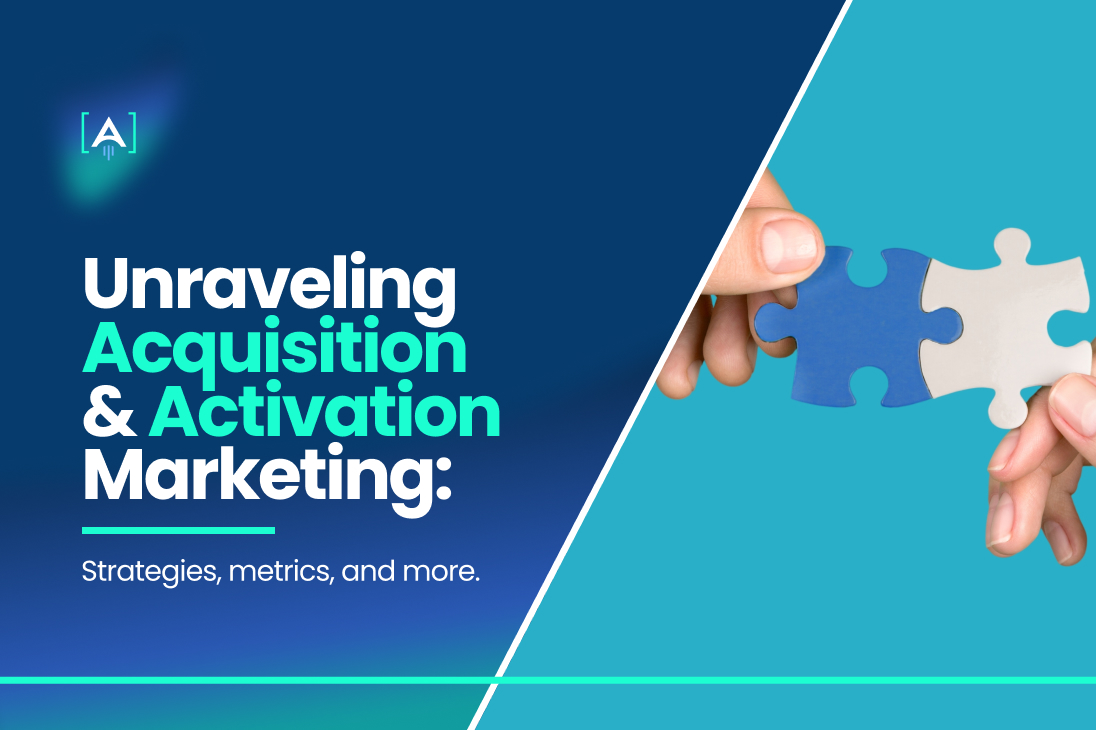Ever wondered what’s the secret sauce behind startups that gain users in droves and, more importantly, make them stick around? You’re not alone.
The twin realms of acquisition marketing and activation marketing often puzzle many people.
But here’s some good news: today, we’re embarking on a journey to demystify these concepts by clearly explaining acquisition vs activation – what each means, how they differ, and why both matter deeply to your business.

So, whether you’re a newbie to the startup world or a seasoned entrepreneur looking to refine your strategies, partnering with a conversion rate optimization agency can provide the expertise needed to maximize both user acquisition and retention.
A Quick Guide to the AAARRR Framework
Alright, before we dive deep, here’s a snapshot of the famous AAARRR framework, the go-to roadmap for many startups:
- Awareness: This is the ‘Hello!’ phase. It’s when potential users first discover your brand.
- Acquisition: Once they know you, this is about getting them interested. Think of it as the first handshake.
- Activation: The first date! You’ve got their interest; now give them a memorable experience.
- Retention: You’re building a relationship here. Keep them engaged, and they’ll stick around.
- Referral: Good experiences get shared. Happy users will introduce their friends.
- Revenue: When value is delivered, users are happy to invest.
Today, we’re setting our sights on Acquisition and Activation. These stages are crucial to nail if you want to build a strong and lasting connection with your users.
Introduction to Acquisition and Activation Marketing
In today’s dynamic digital landscape, acquiring and activating new customers effectively is akin to mastering a finely tuned instrument.
Defining Acquisition in a Startup Context
In the grand startup odyssey, customer acquisition refers to that exhilarating phase of drawing potential users into your universe. Every business has its unique dance steps—perhaps it’s a free trial for a SaaS platform or the allure of a mega-sale for an e-commerce venture.
The real challenge? Determining the intensity of your customer acquisition efforts. A high-octane push might bring a rush of users, but it comes with its set of costs. It’s like setting the stage – you want a full house, but not by compromising the show’s quality.

Now, the digital realm, with giants like LinkedIn for the B2B software niche, beckons most startups. Yet, let’s not forget the power of old-school: events, partnerships, and even a clever t-shirt contest like Invision’s can work wonders.
Remember, it’s not about just adding numbers but understanding the Long-Term Value (LTV) of each user. Because sometimes, quality indeed trumps quantity.
The Mechanics of Activation Marketing
You’ve attracted the crowd; now, how many customers do you make them groove to your tunes? Welcome to the world of activation marketing. This is where users find their rhythm with your products or services.
That magical moment when they nod in appreciation, realizing they’ve hit the jackpot, is the activation moment.
Here’s the clincher: activation is the bridge to customer retention. A well-crafted onboarding experience can make all the difference—just ask Ghost, who saw conversions skyrocket by a whopping 1000% with a simple tweak.
However, first impressions are hard to erase. Monitoring that first-time user experience (FTUX) ensures you’re hitting the right notes. As the song evolves, so should the user’s journey.
How Both Processes Interlink
Visualize a funnel. You’ve got a mix of potential customers at the top. As they shimmy down, they go through the beats of acquisition and activation. A missed step? They could lead to customer churn.

So, keeping the dance smooth between acquisition and activation is crucial. The beauty is one can influence the other. A delighted paying customer can become an ambassador, inadvertently boosting your acquisition.
The synergy between these two can set the tempo for your recurring revenue growth. The harmony results in predictable growth, while stumbles can lead to erratic patterns.
Metrics that Matter: Tracking Success in Acquisition and Activation
Metrics in the marketing realm are like the compasses of old-world sailors: they guide us, ensure we’re on the right track, and indicate when it’s time to adjust our course. However, not all metrics are created equal. To truly steer our ship toward success, we must understand which metrics truly matter.

After all, what’s the point of tracking something if it doesn’t impact your North Star, right?
So, let’s zero in on those critical indicators that’ll help you ensure your acquisition and activation strategies are on point.
Key Acquisition Metrics
- Cost per Acquisition (CPA): How much are you spending to acquire new? It’s crucial to ensure you’re not breaking the bank for each new user. Find the perfect customer acquisition cost ratio.
- Customer Acquisition Channel Efficiency: It’s not just about where your existing customers are coming from, but how effectively. Are customer acquisition channels like LinkedIn or X giving you the most bang for your buck?
- Customer Lifetime Value (LTV): You’ve heard this term earlier and for a good reason. This metric helps you understand how much a customer is worth over the duration of their relationship with you. It’s the counterbalance to CPA and helps determine how much you should be spending on acquisition.
- Churn Rate Post-acquisition: Acquiring a customer is one thing; retaining them is another. If they’re leaving soon after coming on board, it’s a sign something’s amiss.
- Referral Rates and Organic Growth: When your users become your brand ambassadors, it’s the best form of advertisement. Are your current users referring others to you? If yes, give yourself a pat on the back!
Activation Metrics to Monitor
- Time to Activation: How long does it take for a new user to get to their “Aha!” moment with your product or service? Quicker is usually better.
- Activation Rate: Out of the new sign-ups, how many are truly becoming active users? A high activation rate indicates you’re on the right track.

- User Journey Mapping and Touchpoints: It’s like creating a treasure map of your user’s journey. Identify the crucial points where they engage, falter, or drop off.
- Feature Engagement Rates: Which features of your product or service are getting the most love? This can guide your future development and marketing efforts.
- Feedback and User Sentiment Analysis: What are your paying customers saying? More importantly, how do they feel? Sentiment analysis can provide a goldmine of insights.
Analytical Tools and Platforms
The modern marketer’s toolkit is rich with tools designed to tap into these metrics. Here are some game-changers:

- In-app Analytic Tools: These platforms not only allow you to understand user behavior within your app but also help tweak experiences in real-time.
- Customer Relationship Management (CRM) Systems: Keep a finger on the pulse of your customer’s journey, from acquisition to feedback.
- Behavior Flow Charts and Tools: These allow you to visualize the paths users take, spotlighting areas of friction or drop-offs.
Strategies for Effective Customer Acquisition
Effective customer acquisition isn’t a game of chance. It’s a calculated approach backed by understanding and tailored strategies.

Establishing a clear plan is the foundation for your business’s sustainable growth. Let’s explore the strategies that have been making waves in the customer acquisition arena.
Target Audience Analysis
Imagine trying to strike up a conversation in a language you barely know. Tricky, right? That’s why truly understanding your audience is like learning their language.
Let’s begin by sketching out user personas and diving into their pain points.
When we frame our solutions around their specific needs and align our value proposition accordingly, it’s like having a fluent conversation with them. And guess what? Predictive modeling can even let you predict what they’ll say next!
Omnichannel Marketing Approaches
Picture your audience hopping from one platform to another, and you’re right there with them every step of the way. Sounds dreamy? That’s the magic of omnichannel marketing. Whether they’re scrolling through social media, searching on Google, or attending events, your presence is felt.
By weaving SEO, digital ads, content marketing, and partnerships into this mix, you’re not just following them; you’re leading the dance.
Feedback Loops and Refinement
The world of marketing is ever-evolving. Thus, the strategies that worked yesterday might not necessarily be effective tomorrow. Regularly refining your approach is crucial.

- Keep a close eye on your strategies with real-time data monitoring.
- Actively seek and iterate based on feedback, ensuring your strategies are always in tune with your audience’s needs.
- Continuously enhance user experiences (UX) to keep your audience engaged.
- Commit to continuous learning and upskilling, ensuring you’re always at the forefront of the latest trends and best practices.
Unlocking Activation with Innovative Techniques
Activation is where the rubber meets the road, right? And, in today’s buzzing digital ecosystem, ensuring your users find their groove quickly can be the difference between a fleeting visit and a long-term relationship.

Let’s dive into how you can get that spark going!
Crafting the Onboarding Experience
Remember Ghost? They revamped their onboarding flow and witnessed a staggering 1000% increase in conversions. First impressions matter, and a well-structured onboarding can make all the difference.
Guided product tours introduce users to core functionalities, while gamification elements ensure they’re not just learning but also enjoying.
Personalization and customization show users they’re more than just a number. And, of course, there’s feedback collection during onboarding—because continuous improvement is the name of the game.
Leveraging In-app Communications
In-app communication is like having a tour guide on a journey through a new city. Tooltips and models are the helpful hints, while chatbots are the ever-ready assistants, jumping in when needed.
Personalized messages based on user behavior foster engagement, and announcements keep users updated with the latest features. Staying in touch and being contextually relevant is key.
Continuous Engagement Initiatives
Keeping the spark alive post-activation is crucial. With webhooks, you can re-engage those who’ve taken a backseat. Live product demos and webinars, much like Invision’s growth strategy that leveraged word of mouth, can be instrumental in retaining and expanding the user base.

Resource centers, feature updates, and celebrating user milestones can go a long way in building a lasting bond with your users.
Avoiding Common Pitfalls in Acquisition and Activation
The road to successful acquisition and activation isn’t always smooth. Like a skilled marketer fine-tuning a campaign, it’s essential to recognize potential missteps and course-correct before they escalate.

Let’s delve into these pitfalls and ensure your growth marketing strategies are resilient and effective.
Overlooking User Needs
You’ve probably heard the adage, “the customer is always right.” In growth marketing, it’s more like “the user’s needs are paramount.” By sidelining what your users truly want, you risk creating strategies that are off-target.
Assumption-based decisions can lead to missed opportunities. So, how do we ensure we’re on track? Prioritize user-centric strategies.
Dive deep into user feedback, be it direct comments or indirect signals like drop-offs. And when churn seems high, it’s time to re-evaluate and act.
Because understanding user needs is like having a north star in the vast universe of marketing.
Over-reliance on Single Channels
In a 2023 survey, 84% of B2B marketers and 54% of B2C marketers said they used LinkedIn for business marketing. While LinkedIn might dominate, neglecting platforms like X or Instagram might mean missing out on a sizable audience. It’s a delicate balance—leveraging the power of primary channels without putting all your eggs in one basket.

Monitoring channel performance, adapting to platform changes, and recognizing the signs of audience fatigue can prevent saturation and ensure a diversified, effective approach.
Missing Activation Signals
In the cacophony of digital engagement, the subtle tunes of activation signals can sometimes get lost. But just like a musician recognizing a missed note, marketers must be attuned to early warning signs.
Delays in activation disconnect between features offered and what users are seeking or overlooked feedback mechanisms can stall growth. It’s like leaving money on the table.
By actively listening, both to in-app signals and external feedback sources, you can ensure that every beat of your activation and customer acquisition strategy hits the right note.
Integrating Advanced Technologies
Navigating the world of marketing today means being at the forefront of technological advancements. As digital landscapes evolve, it’s the fusion of cutting-edge tech with creative strategies that truly sets brands apart.

Here’s how:
AI and Machine Learning in Marketing
Enter the realm of AI and Machine Learning – your new partners in delivering refined marketing strategies.
- Predictive analytics makes deciphering user behavior feel almost like mind-reading.
- Gone are the days of one-size-fits-all: personalization algorithms curate experiences tailor-made for each user.
- Have a query? Chatbots and AI-driven support are on standby, ensuring questions never go unanswered.
- Dynamic content optimization ensures that what users see is always fresh and relevant.
- And let’s not forget anomaly detection, keeping brands vigilant and proactive.
Automation for Seamless Experiences
Automation is like having a dedicated backstage crew, making every aspect of the user journey smooth and hassle-free.

Imagine the impact of perfectly timed email sequences sparking user engagement or in-app messages triggered by specific user behaviors. Then there’s the art of streamlining data collection, so insights are always at your fingertips.
By integrating various platforms, you achieve a unified data view, ensuring you never miss a beat. And with automated feedback loops, staying updated with user sentiment becomes second nature.
Together, these technologies provide marketers with the tools they need to craft experiences that are memorable, highly efficient, and impactful.
Future Trends: Navigating Acquisition and Activation in the Next Decade
The future is an exhilarating blend of opportunity and uncertainty, especially in the dynamic world of acquisition and activation.

As we stand on the precipice of a new era, here’s what to anticipate:
Evolving User Behavior and Expectations
- Emerging Leaders: Gen Z is stepping up, not just as consumers but as influential decision-makers.
- Safety First: With cyber risks looming, the emphasis on privacy and data protection has never been higher.
- Tailored Touch: Gone are the days of generic. Today, it’s all about crafting personal, memorable experiences.
- More than Just a Brand: Today’s users resonate with brands that stand for something, seeking authenticity and values they can align with.
- Seamless Transitions: Cross-device and platform experiences are the expectation, ensuring users can switch between devices without missing a beat.
The Role of Big Data and Analytics
In an age where every click tells a story, Big Data is the storyteller. The capability to process data in real-time is no longer a luxury but a necessity. Imagine foreseeing user needs before they even arise – the future of predictive analytics.

This enormous pool of insights paves the way for product enhancements that truly resonate.
However, with great power comes great responsibility, emphasizing the ethical use of this data. And as the lines between offline and online blur, the integration of these data sources becomes pivotal.
Adapting to a Rapidly Changing Tech Landscape
The tech horizon is ever-shifting, but here’s the catch: it’s those who embrace this constant flux that truly thrive.
Staying updated with the latest tech innovations, committing to lifelong learning, and being agile are no longer options—they’re imperatives. As new platforms emerge, their swift integration can be the difference between leading the pack or playing catch-up.
And while the future might bring unforeseen challenges, remember adaptability is the name of the game, and embracing change is the only way forward.
Cultivating Growth in Tomorrow’s Marketing Horizon

In the dynamic world of growth marketing, the challenges and opportunities are ever-evolving. Staying attuned to user needs, leveraging data-driven insights, and adopting forward-thinking strategies are no longer optional—they’re essential.
As we reflect on our journey through acquisition and activation, the path ahead beckons with promise.
With a commitment to continuous learning and a focus on creating unparalleled user experiences, marketers are poised to drive unparalleled growth.
The marketing horizon is vast, and with the right tools and mindset, success awaits. Dive deep, innovate, and shape the future of growth marketing!

